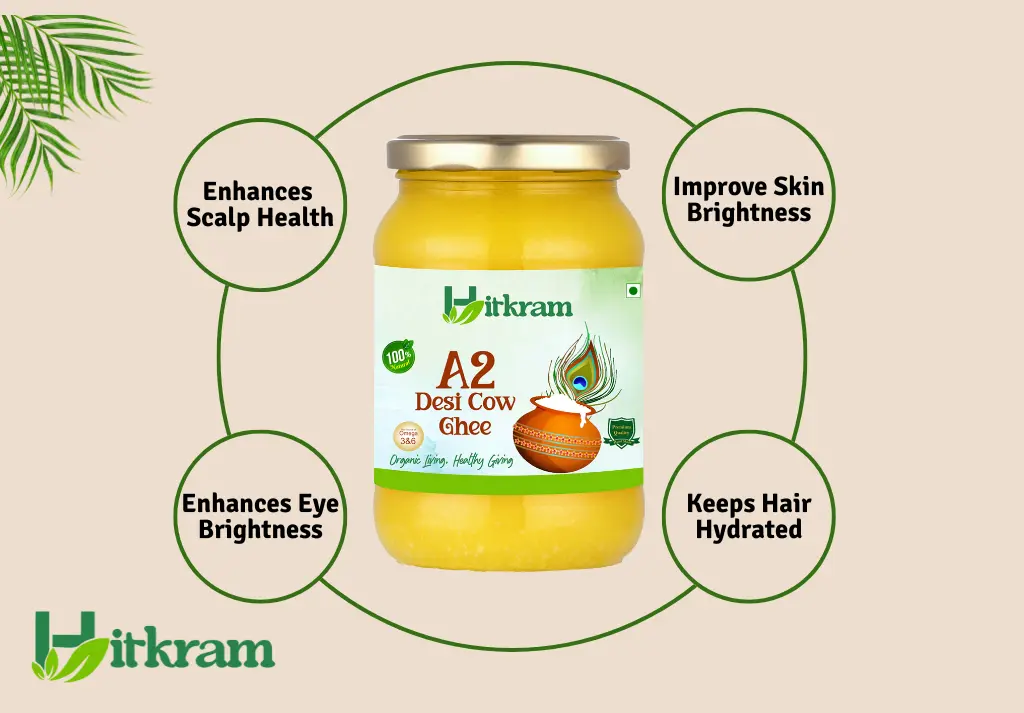Ghee, made from either cow or buffalo milk, gives wonderful fitness advantages and culinary uses. Buffalo ghee is wealthy, creamy, and power-dense, making it ideal for those needing better fat intake or a stronger taste. Cow ghee, lighter and easier to digest, is best for normal use and promotes digestive and coronary heart health. Both forms of ghee provide critical vitamins like vitamins and butyrate, a brief-chain fatty acid beneficial for intestine health. This manual explores the variations between buffalo and cow ghee, assisting you to choose the first-rate alternative primarily based on your fitness desires and cooking alternatives.
Why Choose Buffalo Ghee?
Buffalo ghee made from buffalo milk is a wealthy and creamy variation of ghee, known for its severe flavor and excessive fat content. It is usually chosen by individuals who prefer the best creamy texture. Buffalo milk has greater fats than cow’s milk, so the ghee made from it also has a fat content.
In addition, buffalo ghee is thought to be rich in vitamins and minerals, including Vitamin A and omega-3 fatty acids.
Buffalo ghee is highly valued for its superior quality, making it a preferred choice for cooking. Learn more about its benefits in Why Buffalo Ghee is a Superior Choice for Cooking.

Why Choose Cow Ghee?
On the other hand, cow’s ghee, made from cow’s milk, is lighter, less rich in fat, and offers a lighter flavour. It is usually selected by people who are searching for an extra balanced and slight option for everyday intake. Cow ghee is praised in Ayurvedic medicines, especially for its healing properties, together with its potential to boost digestion and nutrients.
For people with a greater sensitive digestive tract, cow ghee can be a greater choice because it’s far lighter and simpler to digest than buffalo ghee.
Cow ghee is also less likely to contribute to weight advantage as compared to buffalo Ghee. However, each type of ghee has short-chain fatty acids associated with the reduction of intestinal health and irritation, which makes each alternative beneficial in moderation.

Fat Content and Impact on Cholesterol Levels
When it comes to fat content, buffalo ghee contains a better percentage of saturated fats than cow ghee. This is important due to healthy fats like Monounsaturated and Polyunsaturated Fats may have excellent fitness consequences, immoderate intake of saturated fats has been connected to a growth in LDL levels of cholesterol, which may additionally increase the danger of coronary Heart Disease.
Cow ghee having less fat content, has less of an effect on cholesterol levels when consumed moderately. You can read the Traditional Bilona Method of Making A2 Cow Ghee to know the benefits of cow ghee and how it is prepared by the traditional method.
However, both varieties of ghee include butyrate, a short-chain fatty acid that has been related to superior gut fitness and infection bargain, making each alternative beneficial carefully.
Better Choice for Weight Loss
If you’re trying to manage your weight, cow ghee is the better option because of its lower fat content. Ghee, in standard, is a concentrated source of energy, and at the same time, it gives many health benefits. Cow ghee has a lighter texture and can assist ensure that you don’t exceed your caloric needs at the same time nonetheless providing the blessings of ghee, along with progressed digestion and more advantageous nutrient absorption.
Buffalo ghee, while rich in nutrients and energy-dense, can pose a challenge for those following Weight Watchers due to its high-calorie content. However, it can still be included in a balanced diet but should be consumed more cautiously if you’re aiming for weight loss.
Taste and Culinary Uses
Buffalo ghee is richer and more flavorful, making it best for creamy dishes. Its extreme, creamy texture enhances gravies, curries, and chocolates, presenting a fuller taste.
People who select a stronger flavour often gravitate toward buffalo ghee for its wonderful, hearty taste.
On the other hand, cow ghee has a milder taste and lighter consistency, making it versatile for normal cooking. It is frequently used in extra sensitive dishes, along with sautéing vegetables, drizzling over steamed rice, or incorporating into baked goods. Cow ghee’s impartial flavour profile lets it pair seamlessly with an extensive range of recipes without overpowering other ingredients.
Allergies and Sensitivities
Once clarified, both types of ghee are free of lactose and casein, making them ideal for individuals who are lactose intolerant or have sensitivities to dairy.
However, buffalo ghee, being richer and thicker, won’t be as effortlessly digestible for human beings with very sensitive stomachs. In such instances, cow ghee’s lighter composition may be better tolerated. Those with specific Milk Hypersensitive Reactions should continue with caution, as cross-contamination or lines of milk proteins should affect some people, though ghee is normally considered secure for most humans with dairy intolerance.
Which Ghee is More Suitable for Cooking?
In terms of cooking, both forms of ghee have an excessive smoke issue, which makes them appropriate for high-heat cooking techniques which include frying and sauteing.
However, due to the fact buffalo ghee is richer, it could be better for low and sluggish cooking, where the flavours can expand over the years. Its thicker consistency can add flavour to dishes and might deal with longer cooking periods without breaking down.
Cow ghee, because of its lighter nature, is first-rate for sautéing and stir-frying and may be used as a final touch to drizzle over dishes like lentils or salads.
Its barely milder flavour makes it extra flexible throughout unique sorts of cuisine, whether Indian, Mediterranean, or Western.

Nutritional Composition
The nutritional profile of buffalo and cow ghee differs substantially, generally because of the milk supply.
- Buffalo Ghee: Made from buffalo milk, this ghee tends to be richer in fats in comparison to cow ghee. It consists of higher tiers of saturated fats, which offer more energy. A normal serving of buffalo ghee is frequently extra calorie-dense, with improved tiers of fats-soluble vitamins like Vitamin A and Vitamin D, similar to minerals which include calcium and phosphorus.
- Cow Ghee: Cow ghee is lighter in evaluation, with a decrease in fats and calorie content. It consists of extra monounsaturated fats, which might be considered as healthy for heart patients.
The nutrition content in cow ghee is barely less than buffalo ghee however offers crucial vitamins like Vitamin A and E, the side a first-rate quantity of butyrate, a short-chain fatty acid that has numerous health blessings.
Taste and Aroma
- Buffalo Ghee: The flavour of buffalo ghee is powerful, creamy, and rich. It has a greater excessive aroma in evaluation to cow ghee, which can make it a desired desire for indulgent, hearty dishes like goodies, curries, and gravies. The robust flavour of buffalo ghee is regularly defined as extra “buttery,” which provides a robust flavour to meals.
- Cow Ghee: Cow ghee has a milder, subtler flavour and a greater sensitive aroma, making it flexible for a much broader variety of dishes. It complements slight and smooth meals inclusive of sautéed veggies, rice, and flatbreads.
Its fragrance is much less overpowering, making it appropriate for dishes where the ghee is supposed to beautify the opposite flavours without dominating them.
Digestibility
- Buffalo Ghee: Due to its higher fat content, buffalo ghee can sometimes be tougher to digest for a few individuals. The dense consistency can be hard on sensitive digestive tracts, mainly while fed in massive quantities. However, buffalo ghee contains butyrate, which is useful for intestine fitness, however, the higher fat content can be a consideration for people with digestive worries or an inclination to feel bloated.
- Cow Ghee: Cow ghee is less difficult to digest than buffalo ghee, particularly because of its lighter fat composition. The butyrate determined in cow ghee is thought to help improve digestion, reduce irritation in the gut, and increase wholesome gut bacteria. This makes cow ghee a higher alternative for individuals with extra sensitive digestive systems or for the ones looking to guide average digestive health.
If you are liable to digestive problems or want a gentler option for regular consumption, cow ghee may be the higher choice.
Health Benefits
Both buffalo and cow ghee offer severe fitness benefits because of their nutrient-rich composition. Let’s check the perfect advantages of each.
Buffalo Ghee
- Rich in Saturated Fats and Fat-Soluble Vitamins: Buffalo ghee consists of extra fat-soluble vitamins like nutrients A, D, and K, which can be important for eye fitness, immune traits, and bone fitness.
- Energy-Dense: Due to its better fat content material fabric, buffalo ghee is an amazing supply of power, making it suitable for people with better calorie requirements, along with athletes or humans with physically traumatic jobs.
- Anti-Inflammatory: The butyrate in buffalo ghee has been verified to have anti-inflammatory homes, making it useful for popular fitness and conditions which encompass arthritis.

Cow Ghee
- Supports Digestion: The butyrate content material in cow ghee is especially useful for the digestive device. It enables less irritation in the intestines, complements nutrient absorption, and promotes the boom of beneficial gut microorganisms.
- Heart Health: Cow ghee contains a higher percentage of monounsaturated fat, which might be regarded to aid coronary heart health with the aid of enhancing cholesterol levels and lowering the danger of cardiovascular disease.
- Skin Health: The healthful fat in cow ghee is also remarkable for the pores and skin. They assist in maintaining moisture, main to softer, more hydrated pores and pores and skin. Many humans additionally use cow ghee topically as a moisturizer to address dryness or infection.
- Supports Immune Function: Cow ghee’s wealthy food plan content material fabric, in particular Vitamin A, plays a vital characteristic in boosting the immune device. It additionally has antimicrobial houses that may assist protect the frame against infections.
Both types of ghee incorporate useful quick-chain fatty acids like butyrate, which support gut fitness, lessen inflammation, and provide anti-most cancers homes. Additionally, ghee has been shown to promote higher nutrient absorption from different foods, making it a useful addition to a balanced food regimen.
Which Ghee Should You Choose?
Preference between buffalo and cow ghee relies upon your health dreams and culinary possibilities:
- Buffalo Ghee: Choose buffalo ghee in case you need a rich, calorie-dense alternative that provides electricity and a greater severe flavour for indulgent dishes. It’s perfect for those who require a higher fat intake or want the extra dietary advantages of vitamins like vitamins A and D.
- Cow Ghee: Choose cow ghee if you select a lighter, milder option that’s simpler to digest and lower in fat. It’s extremely good for promoting digestive health, and helping coronary heart health, and is a more flexible cooking fat for normal use.
Both kinds of ghee have their precise health benefits and culinary makes use of them, so identifying which one is better for you relies upon your dietary possibilities, fitness dreams, and the way you propose to use ghee for your cooking.
Whether you choose the richness of buffalo ghee or the milder cow ghee, both provide amazing advantages for fitness when used sparsely. To know in detail about the difference between Cow Ghee and Buffalo Ghee read A2 Cow Ghee vs A1 Cow Ghee: Understanding The Differences.
Why Consider Hitkarm Buffalo and Cow Ghee?
Hitkarm Buffalo and Cow Ghee provide a pinnacle-class form of ghee crafted from the milk of healthy, pasture-raised cows and buffaloes. With a focal point on purity and pleasure, Hitkarm Ghee ensures that every one of their products is unfastened from chemical compounds, components, or preservatives. Their A2 Cow Ghee is made from the milk of indigenous cows, ensuring that it includes excellent, without trouble digestible fats and proteins.
To know more about the benefits of Buffalo Ghee you can read Top 10 Benefits of Buffalo Ghee You Can’t Ignore
Choosing Hitkarm Ghee is funding your fitness with the self-notion that you’re ingesting a 100% herbal product that prioritizes both flavour and nutrients. Whether you pick Buffalo Ghee for its rich power-dense homes or A2 Cow Ghee for its health blessings, Hitkarm Ghee gives you each, making sure that every spoonful is nourishing and proper.
By choosing Hitkarm Buffalo and Cow Ghee, you can rest assured that you are deciding on an extraordinary product that prioritizes both your health and culinary desires.












2 Responses
It’s interesting how buffalo ghee’s higher fat content makes it better for those needing a calorie boost, while cow ghee seems to be the more digestible option for everyday use. I hadn’t realized how each type of ghee could cater to different health needs!
This is a great comparison between buffalo and cow ghee! It’s interesting how buffalo ghee has a richer taste and is more calorie-dense, which makes it a better choice for those needing higher fat intake. On the other hand, cow ghee seems like a better everyday option with its lighter texture and digestibility.